Imagine coming into this room with
only 40 shots in your gun.
This is known as Not-enough-ammo Syndrome.
It can make your games decidedly un-fun,
especially if it's combined with the
Big-pile-of-monsters Syndrome (which is
otherwise non-fatal to a game).
I'm protecting you right now, so you don't
have to worry, and I've given you loads of
ammunition, but what if...?
Not having enough shots to work with,
especially in high-action boards, can
induce your players to become someone
else's players.
Well, if it's a shoot-em-up game, tons.
They should not have to worry about
running out -- worry is not fun.
Also -- when you give them alot of ammo,
it's often good to do it with an object
just GIVEing it to them. It saves them
alot of time running back and forth across
a field of ammunition.
• • • • • • • • •
Barjesse brings up the hypothetical of having to play this board not with the 9700 ammo I had remaining, but with just 40 shots. It would be miserable.
He also brings up the importance of objects over built-ins when it comes to giving large amounts of resources. Again there's no magic number where ammo items are bad and objects are good, but there's definitely tedium at a certain point.
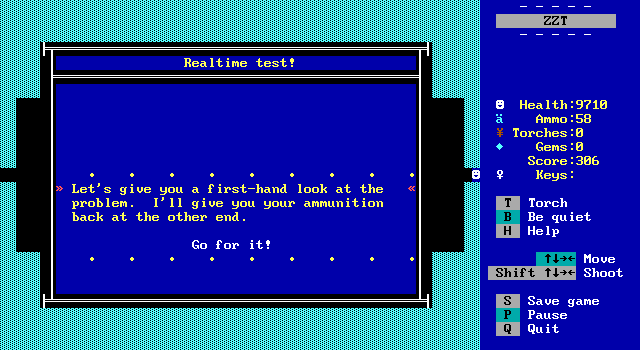
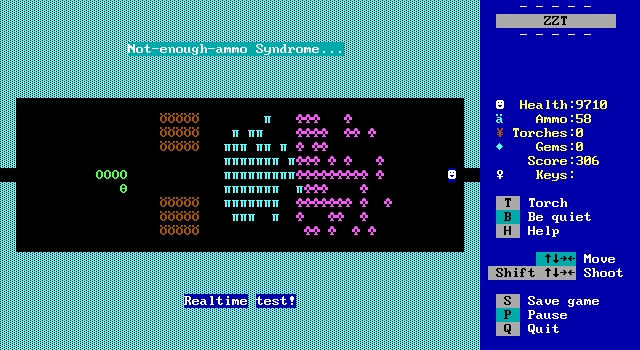
The hypothetical becomes a reality as Barjesse takes away the players ammo and makes them actually fight through a board this time.
An unmentioned Syndrome, is running out of stats. If there are too many enemies and other stat elements on the board, the player (and tigers) are unable to fire projectiles. It's honestly worthwhile to try to not shoot for as long as possible to keep the number of bullets that can be fired at the player low.
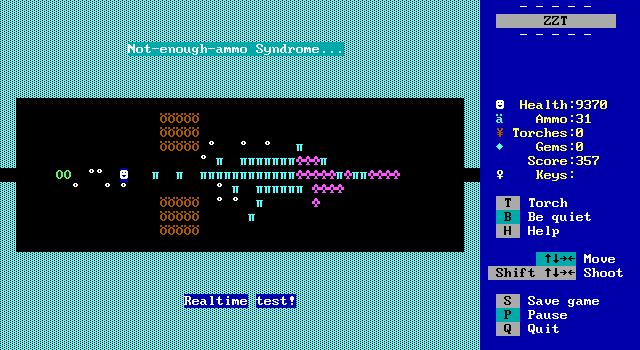
Needless to say, there's no benefit to bothering to fight at all really, and the player is better off plowing through the enemies thanks to the thousands of health they still have.
Were this a game where the player still had only a hundred or so health, it would be complete garbage.
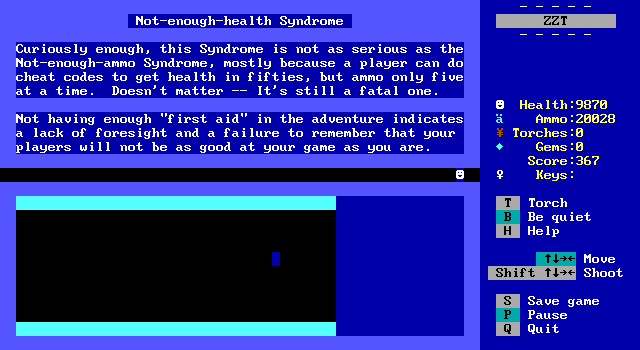
And sure enough, "Not-enough-health Syndrome" is the next one. Barjesse's assessment is correct, cheating for health goes a lot faster than ammo, but if the player is low on ammo when fighting objects rather than default creatures, they probably won't be able to harm them by taking hits.
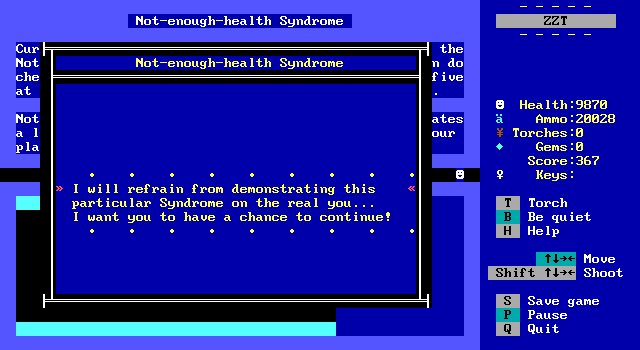
For obvious reasons this one stays as a hypothetical.
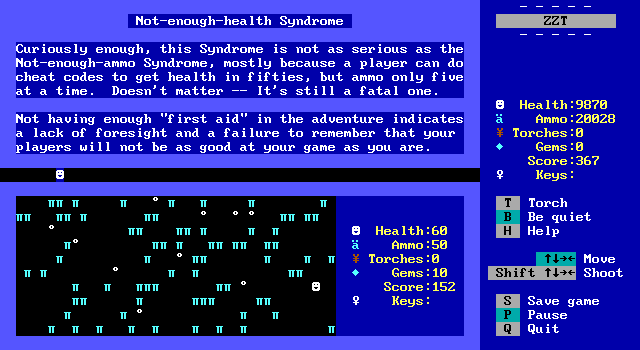
Instead, there's this cute little re-enactment down below with some tigers and an object playing the role of the player.
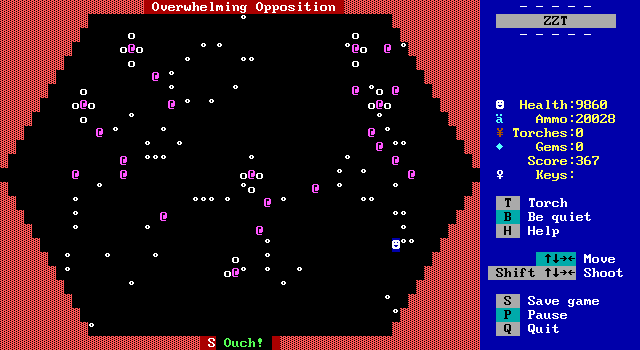
The player is then thrown into the gauntlet with "Overwhelming Opposition Syndrome", where some very fast duplicators rapidly spawn more and more objects that fire extreme quantities of bullets everywhere.
The good news, is that these are the sort of objects that in regular play you may be able to deal with just by relying on them shooting each other, but with so many duplicators here the output surpasses the speed at which they're defeated.
It is nasty. It only takes one screen of
this to completely kill your adventure.
Overwhelming Op is usually too many bad
guys that are way too strong, usually
combined with duplicators and/or stars.
Also, the enemy in this Syndrome are
nearly always objects (which cannot be
shot at point blank range as the normal
critters can).
This means that in no time the player is
swarmed with enemies that cannot be gotten
rid of. Which means "End of Game".
Speaking of which, let's clear this swarm.
I hope the explanation is clear enough.
This syndrome does not happen as often as
some others, but when it does it is
perhaps the most serious and the most
damaging to your otherwise good adventure.
• • • • • • • • •
Barjesse was smart enough to not try to give an answer to "how many enemies is a good number", since it's so dependent on things like the game's tone, player's resources, and what sort of difficulty the author is trying to reach. Object speed, shots fired, shot limits, darkness, ammo, health, architecture, and so much more are all factors in making something feel appropriately balanced.
This is a good example of how just a few
star shooting badguys who are shooting
fairly slowly can become an impossible
obstacle.
Stars are WAY too potent for your own good
they cannot be shot past. This means
that they are not only a great danger to
the player, they are also an impenetrable
obstacle -- blocking the player from
destroying their source.
A handful of star-making critters is
already too many.
A ZZT designer MUST be EXCESSIVELY
reserved in putting stars in his game.
If you put too many in (which is not
many at all), players will abandon your
game.
For a good example of how many stars is
plenty, play Tim Sweeney's "Town of ZZT"
and observe how many stars you see.
• • • • • • • • •
"Too-many-stars Syndrome" is even worse than the previous screen. Stars don't disappear until after a large amount of time passes, can't be destroyed with bullets, and home-in on the player. Oh, they can also push things around. They're incredibly bad and numerous ZZTers suggest pretending they don't exist. Using them effectively is pretty rare.
Town's puzzle that involves them frequently becomes impossible due to stars pushing bombs out of the way which makes it a pretty poor example.
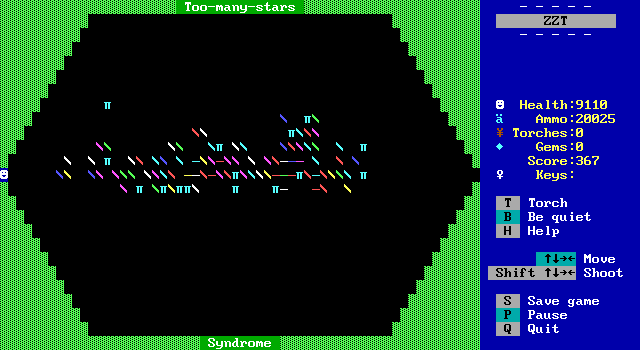
There are 15 tigers on this board, and the best strategy in actual gameplay (as Barjesse destroys them after a few moments) would be to just run around and pray you don't take too much damage. However you almost certainly would. Actually defeating all these tigers would likely take triple-digits worth of ammo and health. I genuinely don't know why tigers even have the option to use stars.
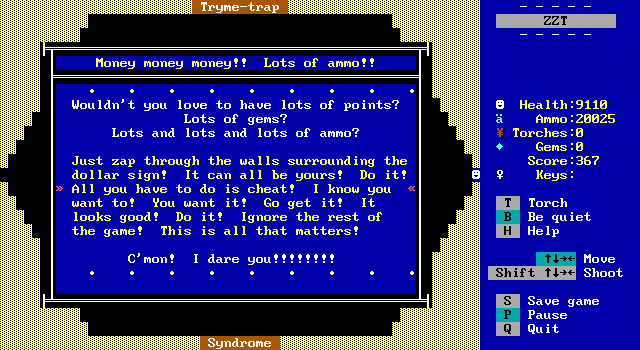
Coincidentally, the Tryme-trap (Try-Me-Trap!) also appears in one of ZZT's original worlds where a series of scrolls warns the player that if they touch the object at the end they will die. This is a bit more blatant in that the player will be killed, and ZZT lets you save at any time so it's easy to come back from your curiosity, provided you thought ahead to save beforehand.
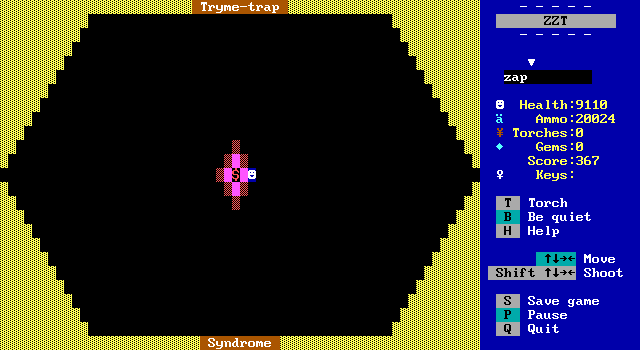

...And then, as soon as you touch it, it
kills you. For no good reason.
(Ignore the message at the bottom of the
screen. That's just there for effect.)
Does this really happen? People don't
>really< do things this dumb, do they?
But when they do, it usually kills peoples
desire to play the rest of the game. Hence
this is a fatal Syndrome.
Beware the temptation of the TryMe Trap:
If you've got security forces on the set,
let them do their jobs in silence. Let
the cheaters really be surprised.
• • • • • • • • •
Barjesse convinces us that these sort of things do exist (correct), and that they're a great way to kill a player's interest in the game (correct). He also suggests keeping anticheat devices quiet to catch those who cheat off guard (INCORRECT).
If. The. Player. Cheats. In. Your. Game. That. Is. Their. Choice.
I strongly disagree with Barjesse and think that any cheat detecting in ZZT is just not worth it. The game outright has an editor, with plenty of tools to modify saves as well. Let people turn the lights on or feel safe with extra health, or just skip awful puzzles!
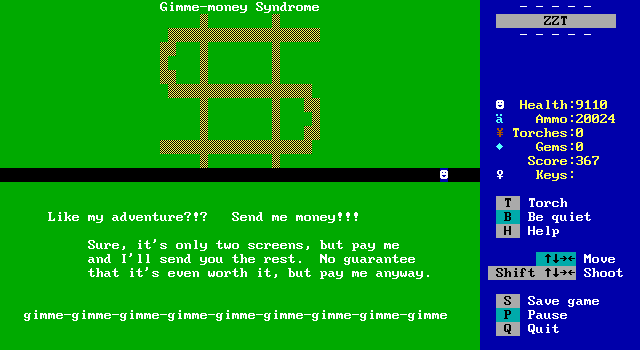
On entering the next board the player gets assaulted with this large flashing dollar sign and demands to pay for a full game.
This is not necessarily a fatal syndrome
every time. It's not necessarily a fatal
syndrome at all. In cases where your
adventure is of professional quality and
professional caliber, it's not even a
Syndrome.
Syndromes and other problems, or when the
adventure is JUST PLAIN POORLY MADE, then
you're looking at a case of Gimme-money
Syndrome.
A designer makes one or two screens, calls
it a promotional demo, publishes a ZZT
"magazine" to push the game, then expects
people to send five dollars to get the
full episode.
Most people will not fall for this scam.
one or two screens.
It can, however, keep people away from any
ZZT adventure with that designer's name on
it. The players learn fast what's worth
downloading and what's sure to be another
G.I.G.O. promo.
GIGO = Garbage in, garbage out.
• • • • • • • • •
Barjesse weighs in on the idea of selling ZZT worlds for money. It's certainly not unprecedented. The original worlds of course, required paying for a registered version, and numerous early ZZT titles have ordering information somewhere. Barjesse is cool with this. However poorly made and incomplete games that interrupt the flow of things to tell you to pay up shouldn't fly. Imagine if games today constantly tried to convince you to put money into them to get something more out of it... ha ha...
There's no real records of the success of worlds that asked for money, good or bad. Obviously Tim found success. Alexis Janson's worlds all offered registered versions as well (which I believe are all the same game, just paying to support the author and get hint sheets and previews of other titles). She did make some money off of MegaZeux and its own registered worlds, but asking for money quickly fell out of favor..
The idea of selling a ZZT game, or buying one, was absolutely absurd to me in the late 90s and early 2000s, and it's only now with the modern independent gamedev scene that exists that I can imagine success with it. Not in the sense of quit your job and put ZZT worlds on Itch, but maybe pick up a few dollars with your game. Of course, I'm also literally being paid money to write this very article so you can definitely monetize ZZT to some degree.
Perhaps ZZTers own image problems contributed to a lack of success here. ZZTers were pretty open about how ZZT games just couldn't compete with major console and PC releases of the era. I think today people respect the art form more, and while I don't think anybody can make a living off of making ZZT worlds, I think the atmosphere is much more positive to having a tip jar and picking up a few dollars that way.
Of course, another major issue is that by the late 90s the ZZT community was almost exclusively unemployed high schoolers who had no money with which to buy ZZT games.
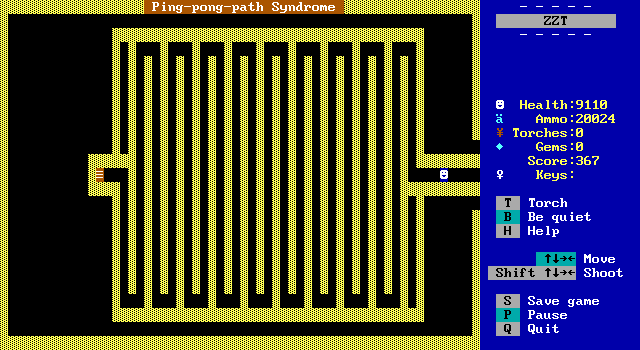
This is it. This is the last one. This is the syndrome of all syndromes. Anybody who has played this world knows what a Ping-Pong-Path is and has kept it close to their hearts. I have seen ZZTers use the term outside of ZZT, and once you have a name for it you'll see it too.
Ping-pong-path Syndrome is one of the few
Syndromes that becomes a Syndrome with
only one incident. It is the ONLY Fatal
Syndrome that is fatal to the adventure
for a reason other than making the game
nearly impossible (aside from the somewhat
rare TryMe Trap and the utterly ridiculous
Gimme-money Syndrome).
That other reason is simply this:
Yep, that's right. A ping-pong path will
dissuade players from finishing your game
AND from downloading any more of your
adventures simply because it is so tedious
to navigate. There is no brainwork
involved here -- simply busywork and time-
wasting.
At some time during the making of some ZZT
game, every ZZT designer is tempted (at
least once) to put one of these in.
Go ahead and try this one...
• • • • • • • • •
Ping-pong-paths can be found in all sorts of games once you know what to look for. While watching a video on creating the Worst Super Mario Maker Level possible, I was excited to see the first attempt was just a ping-pong-path. While I'd generally associate them with _TERRIBLE_ design, there are still instances where they are intentional and can still be made entertaining by what's going on while navigating the path. Probably the "best" ping-pong-path is the (admittedly still optional) 60 floor stair climb in Final Fantasy 7.
May all your creative endeavors be free of the dreaded ping-pong-path.
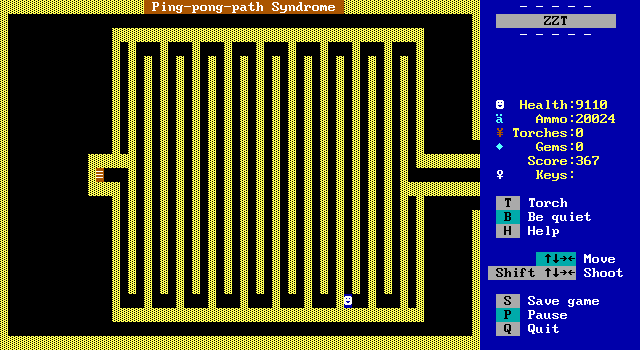
In ZZT here, the player moves approximately 10 tiles in a second. The dimensions of this path work out nicely, taking basically 2 seconds to complete a column and make the turn to the next one. That's a little over 36 seconds to traverse this board perfectly. I promise it will feel like the longest 36 seconds of your life..
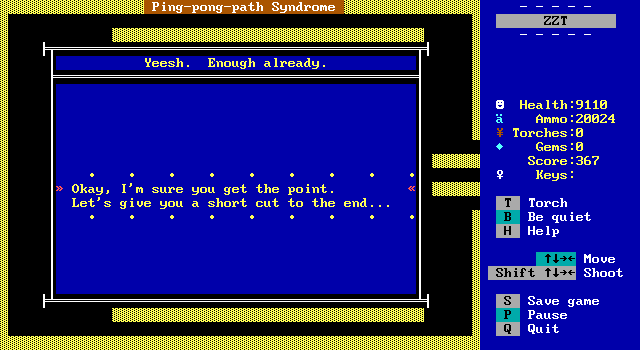
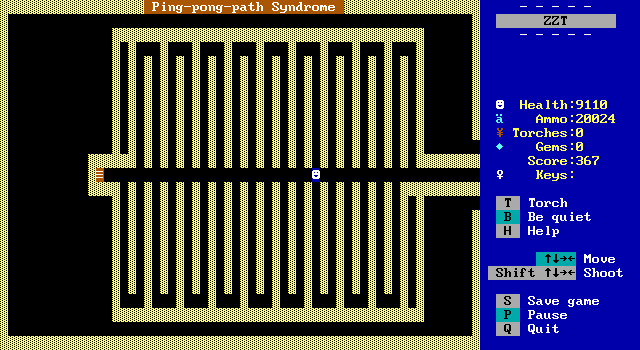
Barjesse is not that cruel. But so many games, and I don't just mean ZZT games, are.

Completing the path leads right back to the beginning where we reach our conclusion. Barjesse has shown us the depths of poor ZZT design, and did quite a good job of it.
Only a small handful are really subjective, and the advice he gives is definitely practical. ZZT Syndromes became mandatory reading for anyone who wanted to make ZZT games that would be taken seriously.
Final Thoughts
ZZT Syndromes became an iconic world, required reading for anybody who wanted to make ZZT worlds. It left an impact on the community by providing quite solid guidelines to consider when making a ZZT game. Barjesse managed to successfully explain common flaws and not come off as disparaging. In a community that was frequently hostile towards those whose games were subpar, I'm glad Barjesse was genuinely interested in some constructive criticism.
To the readers here, the vast majority of the game is pretty obvious. Make sure the player has ammo and health. Don't just pile enemies up without any thought to how the player will fight them. Double-check your spelling. It isn't anything groundbreaking, but it was something a lot of people needed to be told. It's easy to recognize good design 22 years after the release of Syndromes, but for the countless elementary school aged programmers, this was gospel.
Take a look at any old bad ZZT game and just count the syndromes. The idea that board geometry could be important or that maybe a house didn't need to fill the entire screen was a radical idea for a lot of younger folks. The idea that the player's time was valuable and limited goes overlooked in a lot of poorly made ZZT worlds. Sticking to the advice given here to the letter isn't a recipe for success, but it can do quite a lot to mitigate disaster.
Barjesse's positive intentions also shouldn't be understated. An interview with Barjesse in a KerSoft ZZT magazine discusses the inspiration for the game which Barjesse makes very clear that he wanted to encourage newer ZZTers and provide them with solutions to poor design:
I chose to make ZZT Syndromes because it was desperately needed. Many were (and still are) simply insulting or making fun of "newbies" and other poor designers. I didn't like that approach. I wanted to help. So came ZZT Syndromes. It was a positive approach, not just saying "don't do that!" but instead saying "try this instead."
Barjesse's advice continues to be worth taking to this day both within ZZT and outside of it. So be wary of stars, #give resources generously, and think twice before making that ping-pong-path.
(Thanks to Asie for discovering the Kersoft Barjesse interview)
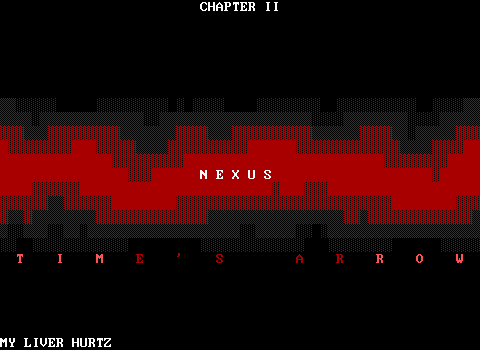

The path leads back to the crossroads (and since you leave from the right side of the big dog board you wind up on the left and immediately have to go left to continue, which sounds like a syndrome to me). The first fatal syndrome involves running across a board populated with a decent number of creatures and duplicators producing more.
Fortunately, it's an illusion here and black walls prevent the creatures from actually harming the player.